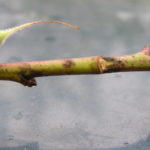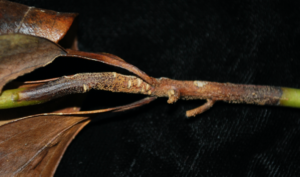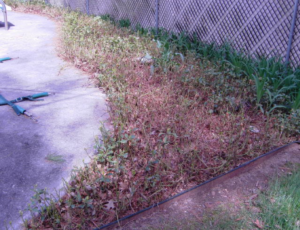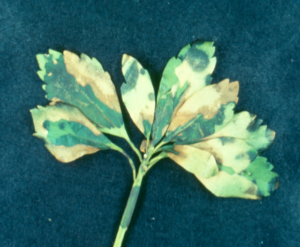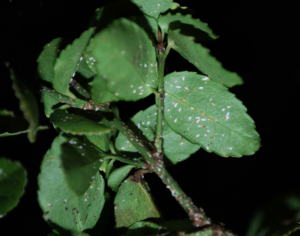Red-headed flea beetle – Adult emergence beginning any day now
- Contains material selection and timing, along with regime information and considerations
Boxwood Blight Alert – Infection Potential (Saturday) 5/27
| Boxwood Blight Risk Assessment as of 5/24/2022 | ||||||||
| Region | Location | CODE | 24-May | 25-May | 26-May | 27-May | 28-May | 29-May |
| Southern | Upper Deerfield | NJ50 | Very Low | Very Low | Low | High Risk | Very Low | Very Low |
| Central | Howell / Freehold | NJ10 | Very Low | Very Low | Low | Infection Risk | Very Low | Very Low |
| Northern | High Point | NJ59 | Very Low | Very Low | Very Low | Infection Risk | Very Low | Low |
| Check local boxwood blight risk here (CLICK HERE – input your area code – select closest weather station – check 7-14 prediction – click on graph / table) | ||||||||
Refer to the most recent Alert for more information – CLICK HERE
Pest Scouting – Please refer to these documents for a full listing of insects pests for your area corresponding to growing degree-days (GDDs).
- Nursery and Landscape Pest Scouting Guide 2022 PDF (note this contains conifer pests as well)
- Conifer Pest Scouting Guide 2022 PDF
Contact if seeing insects at different times: twaller@njaes.rutgers.edu (or call the Cumberland County Extension Office – 856-451-2800)
The following key groups of pests will be active, vulnerable, or otherwise treatable during the next month throughout most of NJ. Here, bagworms, scale insects and borers with key life stage events during the 350-1500 GDD timeframe are discussed. Note there are many other insect pests present this time of year so please view the pest scouting guides above for your particular needs.
| Projected GDD50 accumulation as of 5/24/2022 (USPEST) | Note: Growing degree-day values utilize daily average air temperatures with a minimum temperature threshold (a.k.a. ‘base’) of 50F = GDD50 (max. temp. threshold set at 95F). These values are accumulated from a biofix date, such as January or March 1st in the NE USA. Provided GDD50 are scouting ranges and should be truthed. | |||||
| Region | Location | Station | 24-May | 1-Jun | 1-Jul | |
| South | Upper Deerfield | NJ50 | 488 | 638 | 1358 | |
| Central | Howell / Freehold | NJ10 | 426 | 551 | 1203 | |
| North | High Point | NJ59 | 288 | 387 | 909 | |
| Forecast: NOAA NCEP Coupled Forecast System model version 2 (CFSv2) forecast system (3.5 months) (USPEST.ORG) | ||||||
Refer to this post “Obtaining your local growing degree-days” for additional information
| BAGWORMS (600-900 GDD) (Bagworm hatch prediction as of 5/24/22 – now until July 14 (Southern NJ (NJ50))) | ||||||
| Crop type | Common Name | Scientific Name | GDD Min (50F) | GDD Max (95F) | Reference | Developmental / Target Stage |
| Conifer mostly, many minor hosts | Bagworm | Thyridopteryx ephemeraeformis | 600 | 900 | RU | Larvae (early instars) –
ONLY CONTROL WINDOW |
Refer to this post for additional information on Bagworms
| BORER Insect Activity for 350 – 1500 GDD (Now until ~July 1 in Southern NJ (NJ50)) | ||||||
| Crop type | Common Name | Scientific Name | GDD Min (50F) | GDD Max (95F) | Reference | Developmental / Target Stage |
| Malus, Prunus, many | Lesser peach tree borer | Synanthedon pictipes | 350 | 375 | 4 | Adult flight, egg laying |
| Dogwood, apple, pecan, elm, hickory, willow | Dogwood borer | Synanthedon scitula | 350 | 850 | 4 | adults, eggs, caterpillars |
| Birch | Bronze Birch Borer | Agrilus anxius | 440 | 880 | RU | Adults (egg laying) |
| Malus, Prunus, many | Peach Tree Borer | Synanthedon sp. | 500 | 600 | RU | Adults – emerge (1st treatment both types) |
| Rhododendron | Rhododendron borer | Synanthedon rhododendri | 509 | 696 | RU | Adults emerge |
| Malus, Prunus, many | Greater peach tree borer | Synanthedon exitiosa | 575 | 710 | 4 | Adult emergence |
| Many | Roundheaded appletree borer | Saperda candida | 802 | 1129 | RU | Adults |
| Ash | Emerald ash borer | Agrilus planipennis | 1000 | 1200 | 4 | Peak adult activity |
| Malus, Prunus, many | Peachtree borer | Synanthedon sp. | 1500 | 1800 | RU | Larvae Treatment |
| Many | Roundheaded apple tree borer | Saperda candida | 1514 | 1798 | 5 | Typical treatment window |
| Conifer | Nantucket tip moth | Rhyacionia frustrana | 1514 | 1917 | RU | Adults 2nd generation |
Click here – “Identifying Clearwing Moth Borers in Pheromone Traps” or “Differentiating the Common Wood Borers of Ash Trees”
